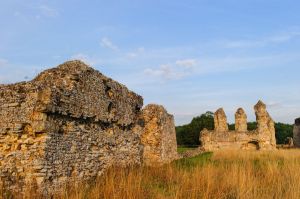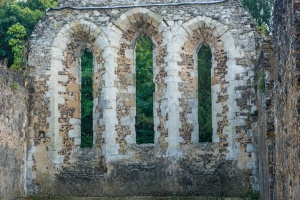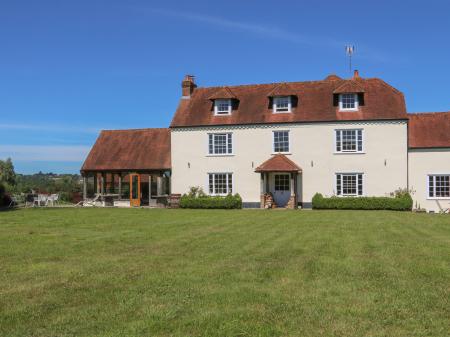
Of particular interest is the lay brother's range, which features two long, arched aisles supported by slender columns.
The Cistercian way of life emphasized manual labour and simplicity, though it helped that they used lay brothers to work their land. The order proved extremely popular in England, and many of the finest and most powerful medieval monasteries were Cistercian.
Within a century Waverley grew to be home to 70 brothers and 130 lay brothers. The abbey was damaged by floods in 1201, and a much larger church built beginning in 1203. The church was not completed until 1278. Most of the surviving monastic buildings date from the period of this 13th-century rebuilding.
Among these buildings are the lay brothers' frater, monks dorter, vaulted cellarer's building, monk's parlour, chapter house, and parts of the nave, presbytery and transepts of the abbey church.

The meadow site is bounded by the river to the south and east, and by a precinct wall to the north. Surrounding the site are remains of the earthworks, abbey fishponds, and a ridge and furrow field system.
Waverley was never very well endowed, and it was in the first wave of monasteries to be dissolved by Henry VIII in 1536. Stones from the abbey were used for local building projects, including Waverley Abbey House, a grand country house built by Sir John Aislabie, Chancellor of the Exchequer, in 1723.
The atmospheric remains inspired Sir Walter Scott to write his novel, Waverley.
Visiting Waverley Abbey
There is a small parking area on the south side of the B3001 by the drive to Waverley Abbey House. From there a signposted footpath leads along the river, with wonderful views across to the elegant House on the far bank. The abbey ruins are in sight the entire way, across level fields. There are several information panels on the site, with maps explaining how the abbey developed over time.
One unusual feature I noticed is that the abbey church was one of the least-preserved parts of the site. With most ruined monasteries that I've visited the church walls or even the nave arcades or windows still stand to a good height, but not so at Waverley, where you have to use a fair bit of imagination to get a sense of the church. By contrast, the lay brothers' range is truly eye-catching, with very well-preserved vaulting and arches.
The really memorable feature of the abbey site, however, is the setting, which is simply wonderful. We came on a late summer evening when the setting sun cast a golden glow over the abbey ruins and the effect was magical; so peaceful and evocative that I didn't want to leave.






brothers' range
 We've 'tagged' this attraction information to help you find related historic attractions and learn more about major time periods mentioned.
We've 'tagged' this attraction information to help you find related historic attractions and learn more about major time periods mentioned.


